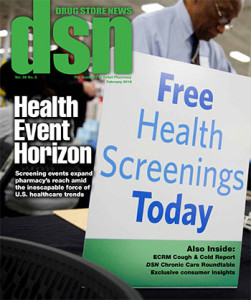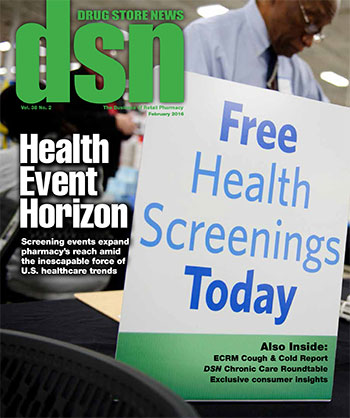 As consumers’ growing financial skin in the health care game compels them to seek care in lower-cost settings, the pharmacy business recognizes the opportunity to provide healthcare services beyond the core business of filling prescriptions.
As consumers’ growing financial skin in the health care game compels them to seek care in lower-cost settings, the pharmacy business recognizes the opportunity to provide healthcare services beyond the core business of filling prescriptions.
This month, Drug Store News (DSN) published a special section called which profiles several pharmacy companies’ expanding reach into retail health – in particular, re-defining the concept of the “health fair.”
A health fair is “an educational and interactive event designed for outreach to provide basic prevention and medical screening to people in the community,” according to the latest Wikipedia definition.
But the health fairs described in the DSN profiles go well beyond the traditional concept. First, the sponsors of health fairs are stakeholders that go beyond those who have provided these programs in the past. Growing recognition that health happens outside of the doctor’s office and hospital walls, where people live, work, play, pray and go to school, expands the geography for prevention and wellness services. That’s on the supply side of the “where” and “who provides.”
On the demand side, “We know people today are extremely busy, and taking time for their personal health can sometimes be a challenge,” Jill Turner-Michael, SVP of consumables and health-and-wellness for Sam’s Club, told DSN. Health screenings provided by the retail store provide an on-ramp to personal health management.
Walmart has had a long history in health fair sponsorship in its communities. “They’re not just important for Walmart; I think they’re critical to the health of our country,” Alex Hurd, Senior Director at Walmart in health and wellness, is quoted.
DSN cites several examples of pharmacies expanding their health fair footprint beyond blood pressure readings. For example:
- CVS Health launched Projecto Salud (Project Health) to provide free health risk assessments in hundreds of communities among its 9,500+ store footprint. The program is staffed by bilingual nurse practitioners and CVS pharmacists, and provides referrals to local practitioners for follow-up.
- Sam’s Club serves up free in-store diagnostic fairs for both members and non-members, expanding its health mission beyond its paying customers into the larger communities where the store operates. The company estimates the value of each screening encounter and review would cost $150 per consumer.
- Rite Aid hosts “Wellness Wednesdays” on a monthly basis in store pharmacies, addressing different health screenings in its communities. Each store identifies a Wellness Ambassador to bolster the wellness strategy, and pharmacists also provide resources and knowledge along with community based doctors and nurses. The chain also has higi kiosks in over 4,100 stores which enable consumers to perform self-diagnostics for blood pressure and other metrics. [See more here in Health Populi in my post, Getting higi with it].
- Walmart boasted “America’s Biggest Health Fair” in October 2015 to focus on prevention and wellness through the store in a one-stop-shopping approach, including the pharmacy, vision care, the Care Clinic, electronics department for wearables, durable medical equipment, fitness products, apparel and food in the grocery. As Michelle Gloeckler of Walmart told DSN, “we’re equipping our customers with solutions for total health management, which spans from nutrition, fitness, preventive care and treatment.”
- Costco focuses health and wellness through the pharmacy, which hosts preventive health services and screening events throughout the year. Costco has sponsored such events since 1998, initially targeting free clinics for osteoporosis via bone-density screening. [Disclosure: I have, gratefully, benefited from these screenings at my local King of Prussia, PA, store]. Through these screenings, Costco consumers become familiar with the pharmacy area of the store.
- Walgreens’ pharmacy footprint of over 8,300 drugstores has become a community-based health touchpoint for many consumers, staffed by pharmacists and other complementary health care professionals. The company promotes flu shots in concert with the U.S. Department of Health and Human Services, offers a blood-pressure program in February as part of Heart Health month, and actively promotes HIV/AIDS testing, among other initiatives.
Taking these initiatives together, the central mission of all of these programs demonstrates “our commitment to keep our communities well,” Jocelyn Konrad, EVP of pharmacy at Rite Aid, said.
Health Populi’s Hot Points: In The Reach and Rationale for Community Health Fairs, a research paper authored by Kate Murray of the University of San Diego and colleagues in 2014, the authors say that, “Community health fairs have developed to address the unmet need for no- and low-cost services that target prevention and education among underserved communities….Health fairs have evolved to fill an unmet public health need, including the dissemination of health information and the provision of screening services… there are indeed community segments that can greatly benefit from such efforts.”
In 2016, who are these “underserved communities” to which Murray and her colleagues refer? In the growing era of high-deductible health plans, and the financial risk-shift for health spending to patients, people who can benefit from this new generation of health fairs is a growing cohort of consumers, well people, sick people, young people and kids, travelers and caregivers.
As Turner-Michael points out, people are busy – and especially, women, the caregivers for their families, most of whom work at some job outside of the home as well as taking on a growing proportion of financial management for their families. The growth of health events can help people manage their health in a DIY healthcare mode on an individual basis. For communities in aggregate, these health events can bolster public health and healthy towns where people live, work, play, pray….and shop. Here’s another sign of the growing retail health ecosystem.





 I am so grateful to Tom Lawry for asking me to pen the foreword for his book, Health Care Nation,
I am so grateful to Tom Lawry for asking me to pen the foreword for his book, Health Care Nation,  I love sharing perspectives on what's shaping the future of health care, and appreciate the opportunity to be collaborating once again with Duke Corporate Education and a global client on 6th May. We'll be addressing some key pillars to consider in scenario planning such as growing consumerism in health care, technology (from AI to telehealth), climate change, and trust -- the key enabler for health engagement or dis-engagement and mis-information. I'm grateful to be affiliated with the corporate education provider
I love sharing perspectives on what's shaping the future of health care, and appreciate the opportunity to be collaborating once again with Duke Corporate Education and a global client on 6th May. We'll be addressing some key pillars to consider in scenario planning such as growing consumerism in health care, technology (from AI to telehealth), climate change, and trust -- the key enabler for health engagement or dis-engagement and mis-information. I'm grateful to be affiliated with the corporate education provider  Thank you FeedSpot for
Thank you FeedSpot for